Azure Hints Series - Containers for Azure DevOps Automation

Introduction
Probably for most of us containers are associated with building cloud-native applications and microservices platforms. The power of container portability makes them attractive when building and architecting cloud solutions. However, they can be really helpful in other scenarios too, like DevOps automation. In this article, I would like to talk about how containers together with Azure DevOps can help with DevOps automation when it comes to Azure cloud solutions.
Why containers for DevOps automation?
First, there can be a question about why containers for DevOps automation? To answer these questions, let me set the stage a little bit. Let’s assume that we use Azure DevOps to keep our solution’s source code together with Azure infrastructure code. Our solution consists of many different Azure Services operating within Azure Virtual Network. To visualize this here is a simple diagram:
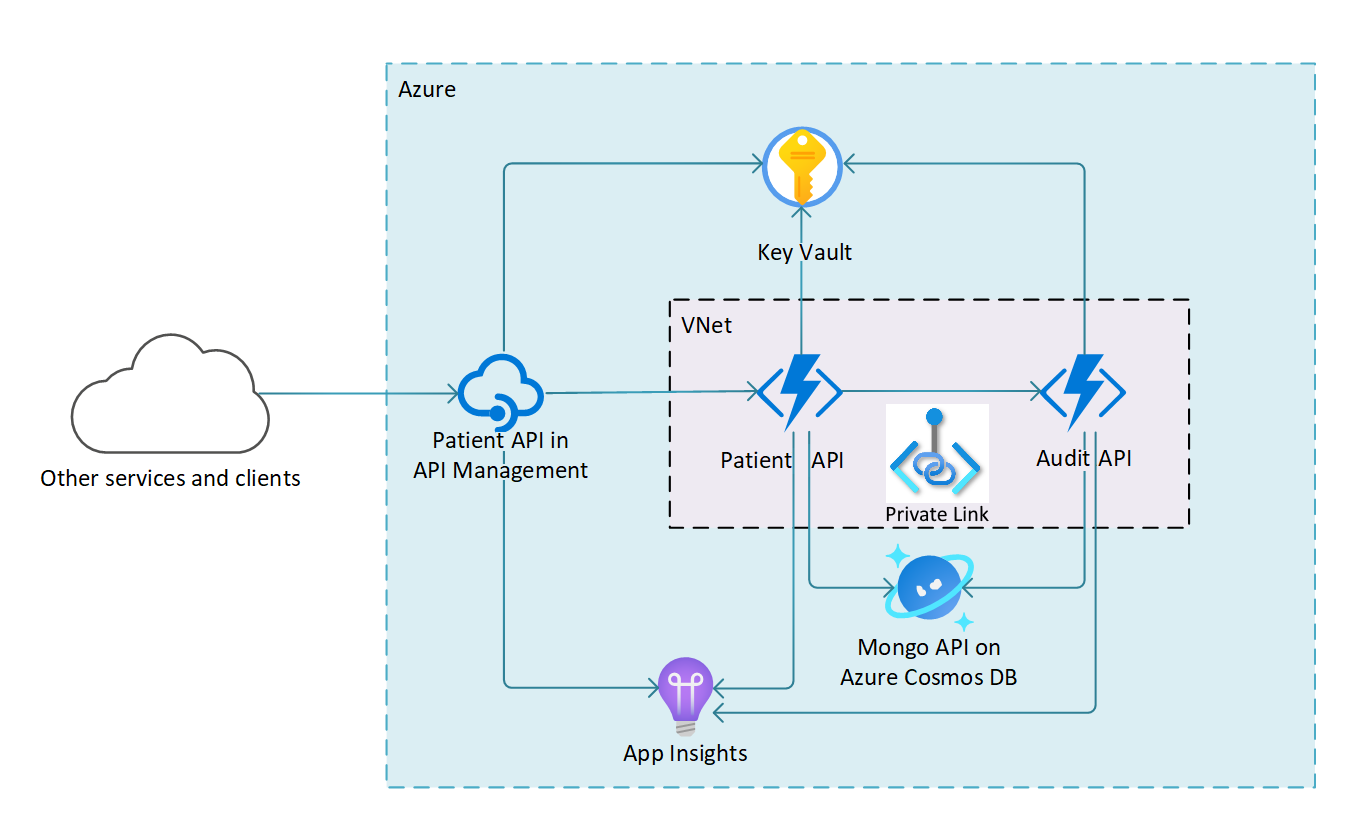
To keep our environment secure, Azure Virtual Network is used and Function Apps are integrated with VNET using Private Links. Probably you know this but with such architecture and configuration using Microsoft-Hosed Azure DevOps Agents can be problematic. Why? Because by default they will not be able to reach Azure Functions to deploy your code. Because Azure resources are located in the Azure Virtual Network, direct access to them is blocked.
In this case, we have three options to still be able to deploy our code using Azure DevOps pipelines:
-
Use Azure DevOps service tag to enable access to Virtual Network from Azure DevOps. This is not a perfect solution because we cannot enable access for specific Microsoft-Hosted Agent, we have to add a whole range of IP addresses. You can read about it here. Sometimes this can be not acceptable due to security restrictions because of the fact that in this scenario our Virtual Network is opened for the whole region of Azure DevOps Microsoft-Hosted Agents, not owned by us.
-
Use Azure Virtual Machine integrated with our VNET and install Self-Hosted Azure DevOps Agent. This will solve the problem with network access but we will face challenges related to VM cost and maintenance.
-
Use Self-Hosted Agents as running containers. In this case, we have three options to run them: Azure Container Instances, Azure Container Apps, and Azure Kubernetes Service. We will talk about each approach later in the article. For sure the benefit of such an approach is reduced cost if we compare it to Virtual Machines.
Virtual Machines vs Container services in Azure
Let’s focus on two approaches when it comes to running Self-Hosted Agents in the Azure cloud to deploy our code in resources within Azure Virtual Network.
Virtual Machines for DevOps automation
The most popular way to use Azure DevOps Self-Hosted Agents is to host them using Azure Virtual Machine that is integrated with Azure Virtual Network. Because of this fact, we can easily deploy code to resources like Azure Web Apps, and Function Apps in the same Azure Virtual Network.
Unfortunately, there are two significant problems with this approach:
- Cost - Azure Virtual Machine is costly. Here is the Linux machine with low configuration. As you can see, the estimated monthly cost is around $13.19. Of course, it can be lower/higher depending on usage but still if we assume that this will be $13.19 per month, per year the cost will be $158.28. If you decide to use a Windows machine, the cost will increase.
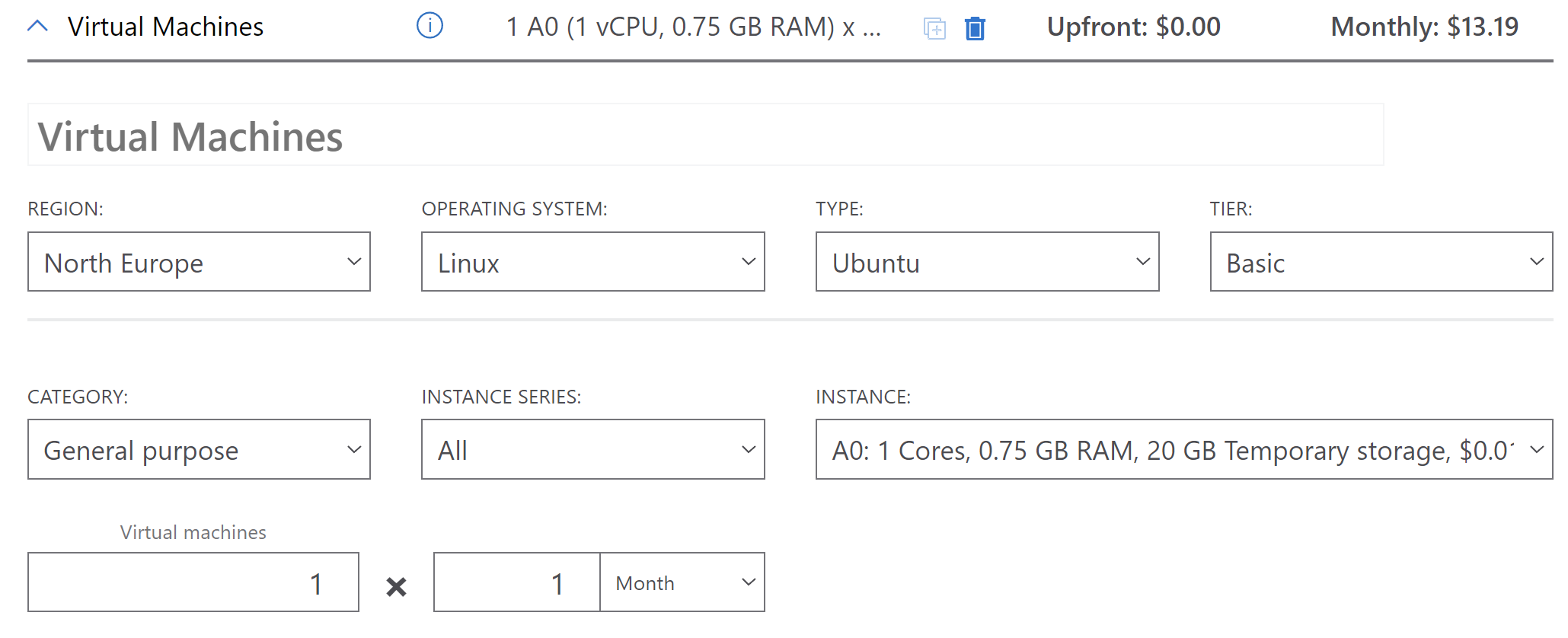
- Maintenance - as you probably know, Azure Virtual Machines are under IaaS (Infrastructure as a Service) cloud service model. It means that there are many things we have to take care of like operating system updates, installation of proper applications, and security:

The positive side of this approach is the fact that we have full control over VM and tools that can be installed. In some scenarios, this can be helpful when we have a complex CI/CD process.
Containers for DevOps automation
Even if containers are associated with building cloud-native applications, they are also a perfect match for running Self-Hosted Azure DevOps Agents. The azure cloud offers many container services but let’s talk about the three most popular and useful when it comes to DevOps automation.
Disclaimer
In this article, I do not focus on creating Docker images with Azure DevOps Agents, however in this great documentation provides step-by-step guide how to create Docker image with Self-Hosted Agent.
Azure Container Instances

Azure Container Instances let you run a container in Azure without managing virtual machines and without a higher-level service. Azure Container Instances are useful for scenarios that can operate in isolated containers, including simple applications, task automation, and build jobs used in Azure DevOps pipelines.
If we take a look at pricing, we can notice that cost is quite low if we compare it to Azure Virtual Machine cost:
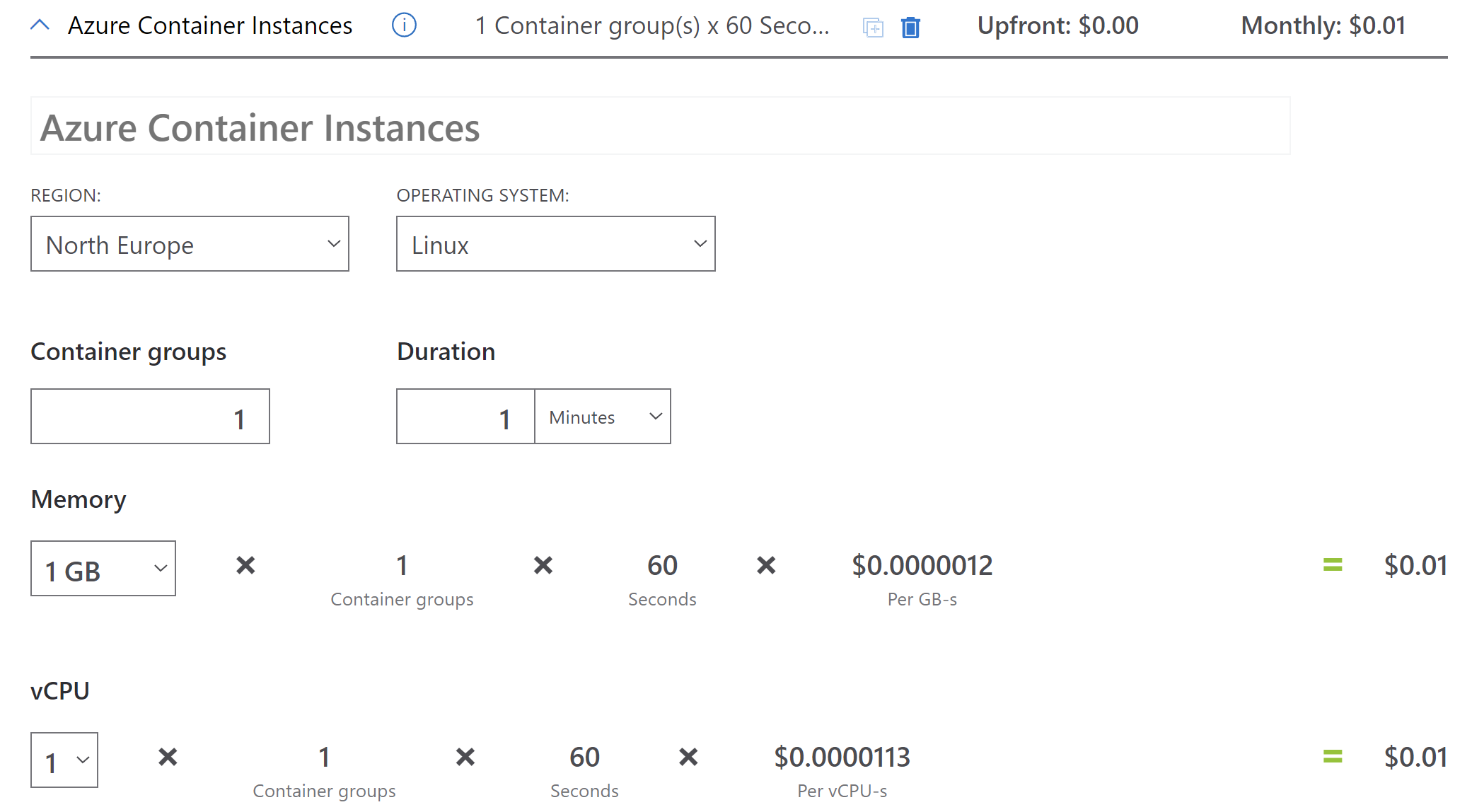
It is worth knowing that when we create Azure Container Instances, we can choose to run one container or group of containers:

A container group is a collection of containers that get scheduled on the same host machine. The containers in a container group share a lifecycle, resources, local network, and storage volumes. It means that we cannot scale them dynamically. Once Container Instance is created, there is no option to scale the number of groups (pods in Kubernetes world).
However, to make it easier to understand the pricing, let’s do the simple calculation provided by the Microsoft calculator.
We create a Linux container group with a 1.3 vCPU, 2.15 GB configuration 50 times daily during a month (30 days). The container group duration is 150 seconds. In this example, the vCPU and memory usage must be rounded up to calculate the total cost.
Memory duration: Number of container groups * memory duration (seconds) * GB * price per GB-s * number of days
50 container groups * 150 seconds * 2.2 GB * $0.00000124 per GB-s * 30 days = $0.612
vCPU duration: Number of container groups * vCPU duration (seconds) * vCPU(s) * price per vCPU-s * number of days
50 container groups * 150 seconds * 2 vCPU * $0.00001125 per vCPU-s * 30 days = $5.063
Total billing: Memory duration (seconds) + vCPU duration (seconds) = total cost
$0.612 + $5.063 = $5.675
It is worth mentioning that price can vary based on the Operating System used for running containers (Windows or Linux). There is an additional charge of $0.000012 per vCPU second for Windows software duration on Windows container groups.
We can use Azure Container Instances to run Azure DevOps Self-Hosted Agents. In this case, once the Container Instance is created, we can schedule the Azure DevOps Pipeline run. In the typical scenario we will run one Self-Hosted Agent in one Azure Container Instance:

It means that if we want more Self-Hosted Agents to handle scheduled Pipelines runs, we will have to create more Azure Container Instances. There is no dynamic/event-driven scaling available. If we will have three separate jobs scheduled in our Pipelines in Azure DevOps, each job will be queued and will run after another.
It is not possible to scale a specific ACI instance. If you want more CPU/Memory you would need to redeploy that container again - this is one of the downsides. There is also one and the biggest disadvantage of this Azure service when it comes to Azure DevOps Sel-Hosted Agents. For example, to scale to five container instances, you create five distinct container instances.
There is no option to scale Azure Container Instances horizontally based on the amount of pipeline runs pending in a given agent pool. It means that we have to architect our pipelines in the way that they first create Azure Container Instance and execute the actual job.
There are also some benefits to using IaaS VMs:
- It does not use public IP’s. It doesn’t need one, as the Azure DevOps agent initiates the communication to the service.
- It does not have any exposed ports. There’s no need for publishing anything.
- Can be provisioned very quickly: to fully configure a container instance with the required components takes 5-10 minutes.
To summarize, Azure Container Instances is a perfect match when we need to run Azure DevOps Self-Hosted Agents, we do not want to maintain Azure Virtual Machines, and we want to reduce the cost. It is worth mentioning that Azure Container Instances can be deployed to Azure Virtual Network so we will be able to reach out to other resources in this network.
Azure Container Apps

Personally, this is my favorite container service in the Azure cloud. Azure Container Apps enables you to run microservices and containerized applications on a serverless platform so you can forget about managing complex Kubernetes clusters but still benefit from Kubernetes concepts.
One of the biggest advantages is auto-scaling. Applications built on Azure Container Apps can dynamically scale based on the following characteristics:
- HTTP traffic
- Event-driven processing
- CPU or memory load
- Any KEDA-supported scaler
Azure Container Apps manages automatic horizontal scaling through a set of declarative scaling rules. As a container app scales out, new instances of the container app are created on-demand. These instances are known as replicas. When you first create a container app, the scale rule is set to zero. No charges are incurred when an application scales to zero.
Can we use Azure Container Apps to run Azure DevOps Self-Hosted Agents? Of course, we can! Let’s dive into the topic and see why the Azure Container Apps service can be more beneficial than using Azure Container Apps.
Scaling
The biggest advantage over Azure Container Instances is the fact that we can automatically scale the number of containers with our Self-Hosted Agents. Here is a great place to mention that Azure Container Apps supports KEDA ScaledObjects and all of the available KEDA scalers. For those of you who are not familiar with KEDA, here is a link. KEDA is a Kubernetes-based Event Driven Autoscaler. With KEDA, you can drive the scaling of any container in Kubernetes based on the number of events needing to be processed.
In the Azure Container Apps documentation, we can find a section with an explanation how to enable KEDA scaling.
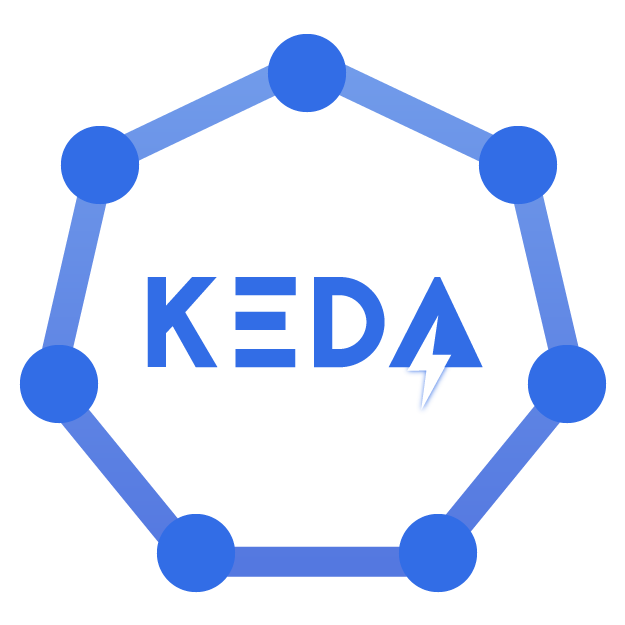
Why do we talk about KEDA and how it is related to Azure DevOps Self-Hosted Agents? We talk about it because with KEDA we can scale Azure Container Apps based on agent pool queues for Azure Pipelines. I encourage you to read the whole article about this topic here.
Below code presents Azure Container App definition using Azure Bicep with enabled KEDA auto-scaling when there are more queued pipelines in Azure DevOps:
resource containerApp 'Microsoft.App/containerApps@2022-03-01' = {
name: contianerAppName
tags: {
'environment': environmentType
}
location: location
properties: {
managedEnvironmentId: containerAppEnvironmentId
configuration: {
activeRevisionsMode: 'single'
secrets: [
{
name: 'acr-password'
value: registryPassword
}
{
name: 'az-devops-pat'
value: azDevOpsPersonalAccessToken
}
{
name: 'az-devops-org'
value: azDevOpsOrganizationUrl
}
]
registries: [
{
server: registry
username: registryUsername
passwordSecretRef: 'acr-password'
}
]
}
template: {
revisionSuffix: revisionSuffix
containers: [
{
resources: {
cpu: json('1.75')
memory: '3.5Gi'
}
image: containerImage
name: contianerAppName
env: envVars
}
]
scale: {
minReplicas: 1
maxReplicas: 10
rules: [
{
name: contianerAppName
custom: {
type: 'azure-pipelines'
metadata: {
poolName: azDevOpsAgentPoolName
targetPipelinesQueueLength: '1'
}
auth: [
{
secretRef: 'az-devops-pat'
triggerParameter: 'personalAccessToken'
}
{
secretRef: 'az-devops-org'
triggerParameter: 'organizationURL'
}
]
}
}
]
}
}
}
}
Let’s focus on the custom scaling rule with KEDA:
resource containerApp 'Microsoft.App/containerApps@2022-03-01' = {
name: contianerAppName
...
scale: {
minReplicas: 1
maxReplicas: 10
rules: [
{
name: contianerAppName
custom: {
type: 'azure-pipelines'
metadata: {
poolName: azDevOpsAgentPoolName
targetPipelinesQueueLength: '1'
}
auth: [
{
secretRef: 'az-devops-pat'
triggerParameter: 'personalAccessToken'
}
{
secretRef: 'az-devops-org'
triggerParameter: 'organizationURL'
}
]
}
}
]
}
}
}
}
As you can see, Azure Container Apps can be scaled basing on targetPipelinesQueueLength parameter value - the amount of pending jobs in the queue to scale on. It means that we can create more pods with Self-Hosted Agents when needed.
Where is the tricky part here? You can run the agents with KEDA as a Deployment or a Job and scale them accordingly with a ScaledObject or a ScaledJob.
The case is that at the moment of writing this article, Azure Container Apps with KEDA supports only ScaledObject. The problem is when container apps scale down, they can stop any instance, including a long-running agent pipeline. When running your agents as a deployment you have no control over which pod gets killed when scaling down. Using a ScaledJob is the preferred way to autoscale your Azure Pipelines agents if you have long-running jobs. I recommend you to read more details in this article.
You can also see that at the moment of writing this article there is opened Issue by Jeff Hollan on GitHub to Support the KEDA ScaledJobs / Jobs Pattern.
Anyway, we can still host multiple Azure DevOps Self-Hosted Agents with Azure Container Apps and deploy them to resources in the Azure Virtual Network because of the fact that you can create Container Apps Environment in an existing Azure Virtual Network.
Cost
When it comes to cost calculation for Azure Container Apps, pricing is quite attractive. Let me start with the important information that the following resources are free during each calendar month, per subscription:
- The first 180,000 vCPU-seconds
- The first 360,000 GiB-seconds
- The first 2 million HTTP requests
Of course, in the case of Azure DevOps Agents the last item above does not apply. Why? Because of the fact that the Self-Hosted Agent communicates with Azure Pipelines or Azure DevOps Server to determine which job it needs to run, and to report the logs and job status. This communication is always initiated by the agent. When it comes to Azure Container Apps cost for HTTP requests, we talk about the number of HTTP requests our Azure Container App receives.
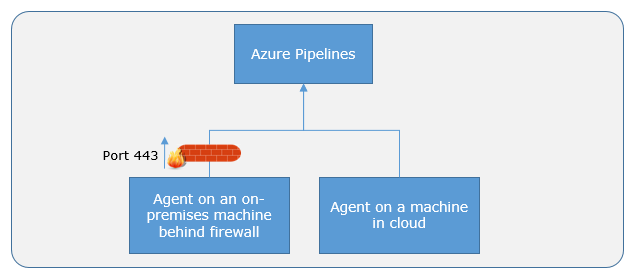
In this case, when we have one Agent running and always ready to execute the pipeline, the average cost can be around $30-40 if we use the lower CPU and memory configuration.
When a revision is scaled to zero replicas, no resource consumption charges are incurred. This is why I am waiting for full KEDA support with ScaledJobs because with that we will be able to scale agents based on the number of queued pipelines.
To summarize, even if we decide that there is always one Self-Hosted Agent running on Azure Container Apps, the cost will be much lower than using Azure Virtual Machines. One more thing - you do not have to use KEDA at all and just have one or a few replicas running with Self-Hosted Agents to handle queued pipelines.
Azure Kubernetes Service
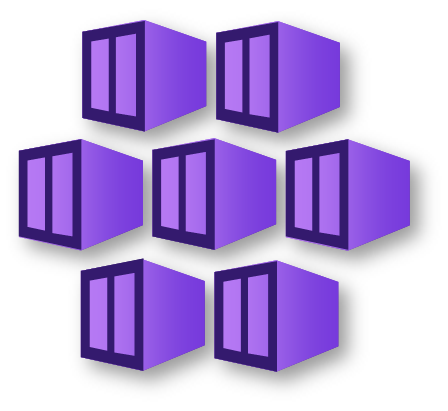
The last option can be helpful when we use Azure Kubernetes Service. In this case, similarly to Azure Container Instances and Azure Container Apps, we can run Self-Hosted Agents in Docker containers. With this approach, we have full control over running containers so in this case, we can utilize the full potential of autoscaling Azure Pipelines Agents with KEDA. In this case, we can utilize ScaledJobs. If you run your agents as a Job, KEDA will start a Kubernetes job for each job that is in the agent pool queue. The agents will accept one job when they are started and terminate afterward. Since an agent is always created for every pipeline job, you can achieve fully isolated build environments by using Kubernetes jobs.
Here is the sample configuration:
apiVersion: keda.sh/v1alpha1
kind: ScaledJob
metadata:
name: azdevops-scaledjob
spec:
jobTargetRef:
template:
spec:
containers:
- name: azdevops-agent-job
image: <azdevops-image>
imagePullPolicy: Always
env:
- name: AZP_URL
value: "<organizationUrl>"
- name: AZP_TOKEN
value: "<token>"
- name: AZP_POOL
value: "<agentpool>"
volumeMounts:
- mountPath: /var/run/docker.sock
name: docker-volume
volumes:
- name: docker-volume
hostPath:
path: /var/run/docker.sock
pollingInterval: 30
successfulJobsHistoryLimit: 5
failedJobsHistoryLimit: 5
maxReplicaCount: 10
scalingStrategy:
strategy: "default"
triggers:
- type: azure-pipelines
metadata:
poolID: "1"
organizationURLFromEnv: "AZP_URL"
personalAccessTokenFromEnv: "AZP_TOKEN"
KEDA will create a Kubernetes job for each pending job in the queue for the specified agent pool and in the end, you will notice that multiple Agents are visible under the pool in Azure DevOps:

In this scenario, I will not talk about the cost because this is a special case valid only when we have an existing Azure Kubernetes Service cluster. Obviously, it does not make sense to create one only for running Self-Hosted Agents. Again - you do not have to use KEDA at all and just have one or a few pods running with Self-Hosted Agents to handle queued pipelines.
Wait - where do I store these Docker images for Agents?
We talked about three different approaches to running Self-Hosted Agents with containers but we did not talk about the registry for Agent’s docker images. Why am I mentioning it? Because this also implicates cost.
In the Azure cloud, we can utilize the Azure Container Registry service to store docker images. There are three different tiers and pricing is different for each of them. Let’s assume that we use Standard tier (middle one). In this case, we have:
- 100 GB storage space for our images
- $0.667 cost per day
To summarize, the estimated monthly cost will be around $20:

It is worth remembering this aspect when calculating the overall cost. However, still, a combination of Azure Container Registry and Azure Container Apps/Instances is much cheaper than using Azure Virtual Machines.
There is also one more great benefit of using Docker for Azure DevOps Self-Hosted Agents. We can define Agent configuration in the DockerFile and make sure that we have a consistent setup every time someone uses our Agent to run CI/CD pipelines.
Summary
In this article, I described the three most popular and helpful approaches to running Azure DevOps Self-Hosted Agents and reducing the cost related to utilizing Azure Virtual Machines. With all three approaches, we can deploy to resources located within Azure Virtual Network which could be impossible with Microsoft-Hosted Agents. I hope this article will help you architect pipelines for your workload deployments.




